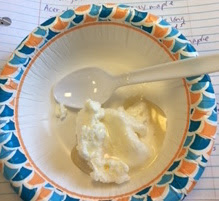I brought an empty SD card along in order to check the game camera currently deployed on our wood duck box. The box was installed in February of 2016. A detailed account of its installation can be seen HERE. Up until this week, the only wood ducks (Aix sponsa) documented around our nesting box were a pair last spring just before the end of school. I took the camera down at the end of April last year assuming there would be no interest from wood ducks that year. This was unfortunate because when I returned last winter to refresh the pine shavings there were egg shells in the box! The species responsible is still a mystery. A female wood duck would line the bottom of the box with dark downy feathers. The only thing in the box last winter were a few tiny egg shells. With the number of cavity nesting birds in Maine, it could have been anything from a songbird to a saw-whet owl (Aegolius acadicus). Needless to say, I plan to leave the camera up for the entire nesting season this year in hopes of documenting any species using the box.
Mystery egg shells found in the nesting box at the end of last year
A pair of wood ducks swim near the nesting box last spring
A pair of wood ducks swim near the nesting box last spring
Upon arrival at the box on Tuesday, I noticed a downy feather clinging to the top of the entrance hole and fresh scratching near the bottom. This is a sure sign that some sort of bird has been in and out of the box recently. I couldn't wait to get back to the room to see what could be on the camera.
A glimpse into the life of a wildlife science teacher
After sifting through dozens of photos of an empty nesting box swaying in the wind on some recent blustery days, the photo I have been waiting a year for appeared. A lone image of a hen wood duck entering the box was the only wildlife documented over the past couple of weeks.
A hen wood duck enters the vernal pool nesting box.
There are a couple of possibilities here. First, this could simply be a hen wood duck checking out a prospective nest site. Her lone appearance and failure to return would indicate that she has not chosen our box. However, the downy feathers and amount of claw marks around the entrance hole have the inner optimist in me hoping that this is not the only trip this hen has made to the box. Could it be that she is coming daily to lay eggs and was even inside incubating when I arrived? I have a feeling that the camera may be pointed a bit too low to pick up a small duck landing on and leaving the nest box. It easily picks up larger movements at water level. I angled the camera a bit higher and am crossing my fingers that this hen will raise a brood here this year. If successful, her ducklings will climb to the entrance hole at just 24 hours old an make the seven foot plunge to join their mother in the pool. In natural tree cavities, some ducklings jump sixty feet or more to the forest floor before being lead by their mother to water. Once down in our vernal pool, they will have all of the invertebrates and amphibian larvae a fast growing duckling could ever need. The ultimate goal would be images and possibly video of this rarely seen moment in a wood duck's life.






























